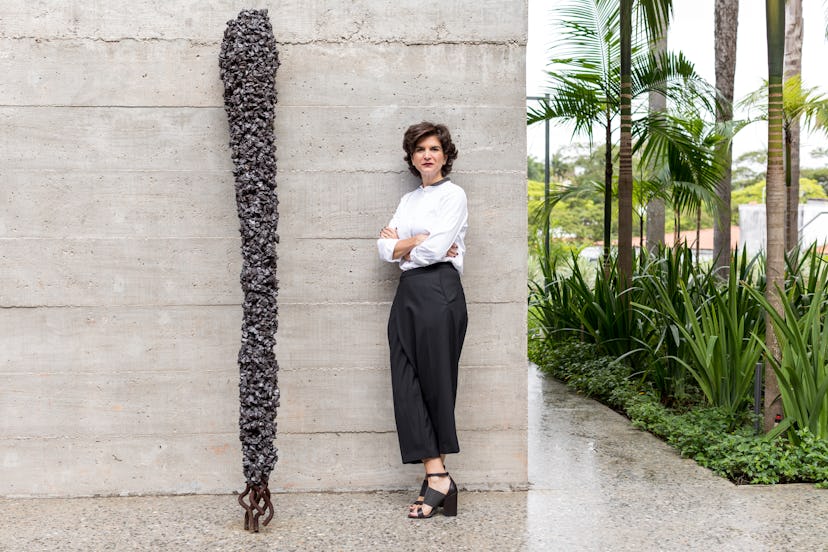Inside the Stunning Urban Oasis in Brazil Where the Art World’s Jet Set Flocks Every Spring
The São Paulo home of Fernanda Feitosa, the founder of the Sp-Arte fair, is a haven of art.

Two weeks ago, during Sp-Arte, São Paulo’s foremost (and only) contemporary art fair, its director and founder Fernanda Feitosa held her annual dinner party to celebrate the official kick-off. Guests entered the property to a find a striking sculpture, by the late Brazilian artist Tunga, of a serpent embedded on the concrete, set above a long lap pool that extends into a yard of terraced planes of more and more concrete. “São Paulo is a concrete city,” Feitosa told me during a tour of her home earlier that week—but a concrete city often made green by Jurassic-size ferns and looming palms, which also veil her property.
“Just a nice little flat!” the art advisor Lowell Petit quipped sarcastically on his way to the caipirinha bar; nearby was work by Adriana Varejão and Mira Schendel. Some had gathered by the pool, others in the property’s dedicated art annex with work by Regina Silveira, but most came together in the house, where Volvis and Tungas, icons of 1960s and 70’s Brazilian art, stood guard over the scene.
From a kitchen boasting a wall-size installation by the Brazilian artist Rivane Neuenschwander, who happened to be present at the party, appetizers and plates of food emerged. A sudden and violent rainstorm triggered a fleet of attendants to whisk those who were dry—literally and figuratively—over to the bar with umbrellas. Curators from the Tate Modern to foundation spaces in Toronto, top dealers from New York and São Paulo, as well as collectors from Los Angeles to Lima all cramped themselves into the house. Feitosa had tried to make this year’s celebration, I learned, more intimate. In years past, the headcount ballooned to hundreds. This year’s supposedly more modest affair was a curated who’s-who of fair VIPs. This house may be the southernmost latitude where the international art-world elite converges year after year.
Built in the 1960s, the Morumbi property in the southwestern part of the city is the home of Feitosa and her husband Heitor Martins, who make up one of São Paulo’s best-known art-world power couples. While Feitosa helms the city’s art fair, Martins, after working with the São Paulo bienal, oversaw the recent revamp of the Museu de Arte São Paulo (MASP). There, the restoration of the Lina Bo Bardi-designed building has won critical and popular acclaim, as the museum’s program continues to mine Bo Bardi’s legacy alongside exhibitions of historical and contemporary artists.
Feitosa and her husband began as collectors, mainly focused on 60’s and 70’s Brazilian modern art, as well as photography, primitive art, and contemporary works. Martins was in finance, while Feitosa practiced as a lawyer. After years living abroad, they returned to Brazil, where she opted not to resume her law career. She was working in business when she had an idea.
“I was curious: Why didn’t we have an art fair like other countries?” Feitosa said when we met at the bienal pavilion designed by Oscar Niemeyer, where the fair is held. “It began with a simple, Why not?”
Her timing was fortuitous. The first edition, in 2005, came just before the global financial crisis, during which time investors looked toward a booming Brazil. “Brazil, at that time, appeared as a promising land,” Feitosa explained of how the fair grew in scale. While the first Sp-Arte featured only one foreign gallery, from Uruguay, that number grew to 17 by 2011; the most recent edition hosted 44 foreign galleries. Much of that growth was helped along by a tax exemption specially engineered by the fair: during the week of Sp-Arte, prohibitive taxes on imported art are lifted. (Without the exemption, taxes on imports in São Paulo can balloon up to 60%.)
“It’s a barrier that has secluded the art market locally for many decades,” Feitosa said. “Most collections are national,” she added, matter-of-factly. “We are really far from everybody.”
São Paulo is home to Brazil’s art scene as well as to its billionaires. Just look to the Jardins mansions, near the city’s top galleries, surrounded by towering walls of concrete. “It’s a natural state to have an art fair,” Feitosa said.
Despite Brazil’s rocky economy and ongoing political crisis, the fair is committed to charging ahead and fostering the new. Last year inaugurated a design sector, and the 2017 edition included 180 official events around the city, at galleries, institutions, and non-profit spaces. The Feitosa-Martins are expanding on the domestic front as well: they recently completed a second art annex, a subterranean space in the backyard that expands the dimensions of their property.
At the party, things began to wind down around midnight—relatively early by São Paulo standards, but then again there were booths to be tended to the next day. Momentarily stuck without a data on my phone, I fretted momentarily about how to get home—taxis are a commodity in the traffic-heavy city, and have to be called ahead on an apps. In Feitosa’s office, amid volumes of São Paulo Bienal and ephemera from the fair, I decided to make one wild guess at the wifi password. “Fernanda,” I typed. Bingo.